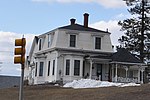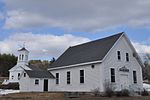Bear Brook State Park Civilian Conservation Corps Camp Historic District
Allenstown, New HampshireCivilian Conservation Corps in New HampshireHistoric districts on the National Register of Historic Places in New HampshireNRHP infobox with nocatNational Register of Historic Places in Merrimack County, New Hampshire ... and 1 more
Use mdy dates from August 2023

The Bear Brook State Park Civilian Conservation Corps (CCC) Camp Historic District is the only surviving Civilian Conservation Corps work camp in New Hampshire. Located in Bear Brook State Park, in Allenstown, the camp's facilities have been adaptively reused to provide space for park administration and a small museum. It is located in the northwestern portion of the park, south of Deerfield Road. It is also believed to be one of the few relatively intact CCC camps in the nation. The district was listed on the National Register of Historic Places in 1992.
Excerpt from the Wikipedia article Bear Brook State Park Civilian Conservation Corps Camp Historic District (License: CC BY-SA 3.0, Authors, Images).Bear Brook State Park Civilian Conservation Corps Camp Historic District
Depot Road,
Geographical coordinates (GPS) Address Nearby Places Show on map
Geographical coordinates (GPS)
| Latitude | Longitude |
|---|---|
| N 43.158055555556 ° | E -71.378888888889 ° |
Address
Depot Road
Depot Road
New Hampshire, United States
Open on Google Maps










